Occassional thoughts about orienteering
| okansas.blogspot.com Occassional thoughts about orienteering |
|
Monday, February 28, 2005  posted by Michael | 7:45 PM 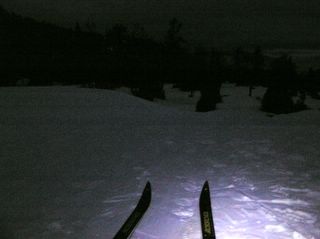 Early morning ski session at Mammoth Hot Springs. posted by Michael | 7:44 PM Some words from Line Hagman on trainingI came across an Norwegian interview with Line Hagman and thought I'd translate a few lines.Do you have a special training philosophy? I follow the normal Norwegian volumen-training model. I do two high [intensity?] sessions a week, plus strength and spenst. Otherwise, I do easy training. I mostly run, but I also ski in the winter. Are you doing any special training to prepare for the coming season? I'm training running technique and intervals on the track to be better at running on flat surfaces. This year I'm also putting in more hill intervals to get ready for Japan. posted by Michael | 7:32 PM Sunday, February 27, 2005 Some O' linksNot much time to write today, so I'll just give a couple of links:Kurt Huber posted maps from the control picking course with 150 controls (world record). Take a look at the south section and then the north section. That looks like fun. If you've got some patience (it takes several minutes to download even with a fast connection), check out a short movie of Fritz (Quicktime format) talking about his run at the local even yesterday. I made the movie with my digital camera as a first test at video-blogging. posted by Michael | 7:43 PM Saturday, February 26, 2005 Local race at Lake JacomoPossum Trot OC used a new map and a new area for today's event. Always fun to get a new area. Dick Luckerman made the map and did a good job.I've posted a couple clips of the map below. The map doesn't make the area look nice. It was nicer than you'd think from the map. I had a good race, running hard and concentrating well. posted by Michael | 6:06 PM  posted by Michael | 6:04 PM  posted by Michael | 6:03 PM Friday, February 25, 2005 Eating instead of trainingInstead of training tonight, I ate. Good food.PEI mussels with mustard soup. Salad of infant spinach, peppered pine nuts, anjou pears, blue cheese and Spanish sherry cream. Volute of clams and celery. Catfish Brandade, encrusted catfish, braised winter cabbage and essence of Paris mushrooms. Delmenico of New Zealand lamb, ragout of leg, chickpea puree and sauce choron. Nashua surf and turf, turf, potato puree with blue cheese, beurre blanc. Knuckle of double creme brie. Charlotte chocolat, bananas and coulis. posted by Michael | 9:32 PM Thursday, February 24, 2005 M21 course from the second day in TexasThe maps below show the M21 course from the second day at Texas. Click on the images for higher resolution. posted by Michael | 7:48 PM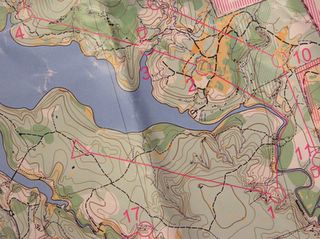 posted by Michael | 7:47 PM 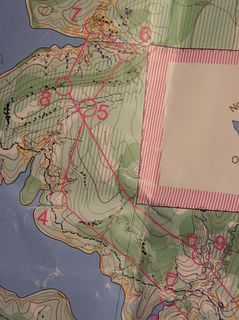 posted by Michael | 7:47 PM 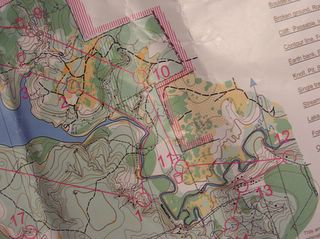 posted by Michael | 7:46 PM 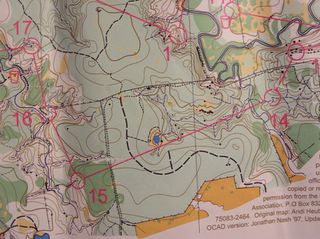 posted by Michael | 7:46 PM 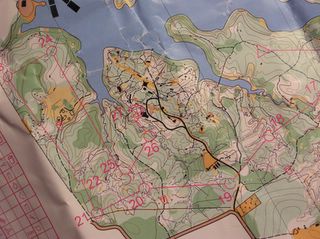 posted by Michael | 7:45 PM Wednesday, February 23, 2005  Mary and I passed this creek on our last day of skiing at Yellowstone. posted by Michael | 9:05 PM Predicting illnessI regularly read the training logs of a dozen or so orienteers. A couple of times in the last few months, I've been reading a log and thought, "I bet they'll get sick in the next week or so."Once, I was right. The person was sick within about a week. Once, I was wrong. The person didn't get sick (though they missed some training in the next week or so with an injury). I can't remember exactly what I was seeing that made me expect the people to get sick. I think a few things came in to play. First, an unusually high training volume (compared to what the person was typically doing). Second, some indication of stress. Third, some travel or other disruption going on. There might have been something else, too. At the time, I thought it'd be interesting to see if I could predict illness. I could keep track of when I expected someone to get sick and then see how I did. I have lots of flaky ideas like this. Sometimes I follow up on my flaky ideas. This time I didn't. posted by Michael | 8:46 PM Tuesday, February 22, 2005  Winter in Yellowstone attracts wolf-watchers. This group had been standing beside the road since sun up (I took the picture around 4 p.m.) watching wolves from the Druid Pack. posted by Michael | 8:03 PM  Mary peering through our little spotting scope, checking out a lone wolf. posted by Michael | 8:01 PM Field checking notesPat Dunlavey posted a bit of the field checking notes from the Surebridge map. The 1993 classic WOC race was held at Surebridge.If you're a bit of a fanatic about mapping, check out the notes. I wonder how many of us who field check make notes that look so good? posted by Michael | 7:50 PM Monday, February 21, 2005 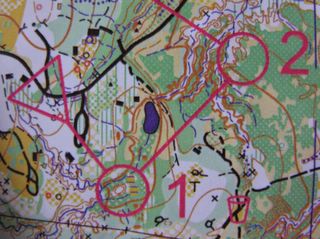 Here are a few map clips from the first day at Texas (the day I didn't finish). The course started with a couple of short, tricky legs through less-than-pleasant terrain. It was a good preview of things to come. I missed one, losing a minute plus. I was wandering in the green, then bailed out to the powerline and attacked from the pole straight south of the control. posted by Michael | 2:13 PM 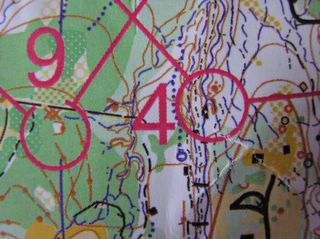 This bit of the map gives you a sense of some of the terrain. Note -- lots of thick forest and some areas of erosion features (quite difficult for me to read even at 1:10,000 and with a magnifier). posted by Michael | 2:09 PM  I called it quits just at the edge of the circle at control 16. From there, I jogged and walked back to the finish. posted by Michael | 2:07 PM 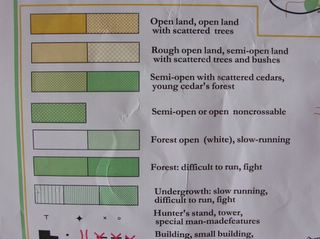 The areas with scattered cedars and young cedars look mostly green, but the running is typically good. posted by Michael | 2:05 PM First report from TexasI'll probably post some clips of the map a bit later today. For now, here is my first quick report:1. Yuck. The terrain in Texas is thorny. The course setters didn't seem to cut us any slack -- if the trade off was technical difficulty versus pleasant, they picked technical difficulty. 2. Good pizza. We ate at the Hideaway Pizza in Tulsa on the way to Texas and the Hideway Pizza in Oklahoma City on the way home. I like the place. Good pizza. 3. Pre-running. The start list for Blue was short (maybe 12 people of so), and widely spaced (ten minutes between starts). My start on day two was near 11 a.m. Given that the first start was 9 a.m. and we had a good 8+ hours to drive home, we asked for earlier start times. "No changes, no exceptions." Well, Tom helped us out and arranged that we could run as pre-runners about 7:30 a.m. Thanks, Tom. That really helped us out. 4. DNF. On the first day I did not finish. I stopped after about 3/4 of the course. I wasn't have a great race. It wasn't terrible either. But, I wasn't having fun. As I approached the 16th control, I looked at the map and wondered, "why did they pick that spot for a control?" It was a very low broad spur in solid green forest. "I don't want to go there." So, I didn't. I stopped and jogged back to the finish. I felt a little bad to give up. But, I wasn't having fun. The second day was better. I had a decent race and a lot more fun. 5. NASCAR. I assumed that we'd be able to listen to the radio coverage of the Daytona 500 on the drive home. Driving through Texas, Oklahoma and Kansas, you'd have no trouble finding NASCAR on the radio, right? Wrong. I didn't find any radio coverage until the last 7 laps of the race. Bummer. posted by Michael | 10:28 AM Friday, February 18, 2005 Next planned update on Monday, Feb 21I'll update this page on Monday (look for maps from Texas then).I'll try to post some audio reports tomorrow and Sunday. posted by Michael | 1:20 PM Thursday, February 17, 2005 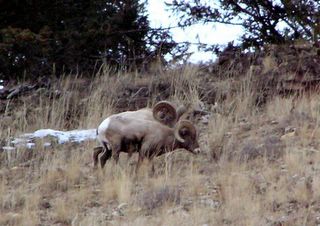 Mary spotted a couple of bighorn sheep as we drove through the Lamar Valley. posted by Michael | 8:09 PM 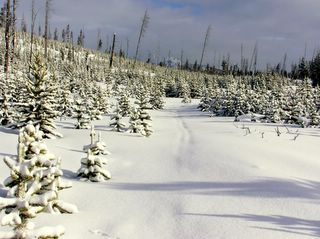 The ski trail (under 6 inches of fresh snow) at Indian Creek. The forest burned in the late 1980s. You can see some of the dead, burned trees in the background. What look like Christmas trees are the forest re-growing after the fires. posted by Michael | 8:04 PM Thinking about TexasI'm going to Texas tomorrow to run the North Texas A-meet. If I remember correctly, I'm running M21. It should be fun.I figured it'd be worth taking a look at the old map of the area. I dug around in my basement for a few minutes and found it. I took a look. A few thoughts came to mind. I expect the vegetation to be less than pleasant. The map has a lot of green. That suits me, I kind of enjoy crappy terrain. The map includes a resevoir. If the water is low, running along the edge of the lake might be worth considering as a route. I'll need to check that out before the start if possible. I'm expecting lots of controls (the map I looked at had an 8K course with 18 controls). I won't be surprised if a few of the controls are a bit bingo. My impression of the Texas O' culture is that some of the course setters like making controls difficult to find. I hope that isn't the case, but I won't be surprised if it is. It looks to me like there are three main difficulties: fighting through the unpleasant areas; holding a straight line through flattish areas (especially in green areas); and recognizing tricky controls and slowing down as needed. While I'm in Texas, I plan to post some audio updates. posted by Michael | 7:51 PM Wednesday, February 16, 2005  The Yellowstone River at Calcite Springs. Click on the image for higher resolution. At the river bend you can see a pile of fallen trees. It looks like smoke rising from the trees, but actually it is steam from the hot spring. posted by Michael | 8:04 PM  A self portait -- an early morning ski session on the upper terraces at Mammoth Hot Springs. posted by Michael | 8:00 PM How to train in ten words or lessIf you had just ten words to explain how to train, what would you say? Here is my first try:Run most days. Orienteer often. Set long-term goals. posted by Michael | 7:51 PM Tuesday, February 15, 2005  Mary on the trail to Lost Lake. The wind was blowing snow down the narrow valley into our faces. The return trip -- downhill and with the wind at our backs -- went a lot faster. posted by Michael | 7:19 PM Yellowstone tripMary and I spent a long weekend at Yellowstone. I'll post a few snapshots below and probably post some more over the next few days. posted by Michael | 7:17 PM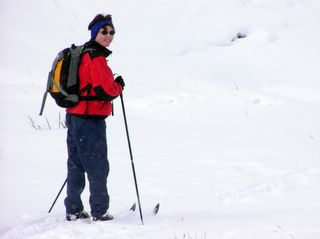 Zooming in with the telephoto lens. posted by Michael | 7:13 PM  We had to wait a few minutes for the Bison to move. posted by Michael | 7:11 PM A map worth a lookTake a look at a night O' race from Kristiansands OK in Norway. Looks like tough orienteering. posted by Michael | 1:24 PMThursday, February 10, 2005 Next planned update on Tuesday, February 15I plan to update this page on Tuesday, February 15. Don't expect to see anything new here until then. posted by Michael | 1:08 PMWednesday, February 09, 2005 Widsom of crowdsLast summer I experimented with an idea I'd read about in the book The Wisdom of Crowds. You can read what I wrote on July 10.I just discovered a Norwegian O' Club using a similar idea to practice orienteering. The club publishes maps with several route choice legs each week. You vote for the leg you think is best and leave comments. At the end of the week, they publish the results and comments. Take a look at last week's results. The page is in Norwegian and I'm not going to bother translating it, but I'll give you the winners on each of the three legs: 76 percent of the votes picked the red route on the first leg. 40 percent picked the blue route on the second leg. 93 percent picked the red route on the third leg. It looks like the club plans to put up new route choice problems each week. You can check them out here. The results would be most interesting if lots of people vote. I don't know if the club is looking to have people from around the world place their votes. But, they aren't preventing you from going in and voting. The instructions are all in Norwegian, which makes it a bit tougher to figure out. Here are some key Norwegian phrases and words translated to English: Beste vegvalg? = best route choice? Gronn, bla, rod = green, blue, red Begrunn valget ditt her, angi evt. tid spart i forhold til andre vegvalg. Dersom du krysset for "annet", beskriv kort hvor du ville løpt. = Explain your route here, describe the time you'd save compared to other routes. If you picked "another", describe how you would run. I think using the internet like this to tap in to the wisdom of crowds is a great idea. If the crowd is large enough, I think you'll likely get a very good idea of which route really is best. If this sort of stuff interests you, you might also check out the book The Wisdom of Crowds. posted by Michael | 7:34 PM Tuesday, February 08, 2005 What does the Junior Team leader do?I've decided I might be interested in doing something with the junior team. I'm not sure. I am sure I will give it some thought.Here are the duties of the Junior Team Leader: Reports to Vice-President of Competition Serves as member of Junior Development Team selection committee in accordance with USOF rules. Serves as member of JWOC Team selection committee in accordance with USOF Rules. Serves as or appoints a Junior Team Fund Administrator. Serves as Team Leader for the JWOC team including: Making all arrangements with the event organizers for the JWOC Team; Personally attending JWOC as Team Leader or appointing an appropriate substitute. Works closely with the National Junior Coach and Vice-President of competition to support the needs of Junior Development Team members. Assists National Junior Coach in development and delivery of national and regional coaching and training systems. Facilitates communication systems for Junior Development Team members including: Junior to Junior networking opportunities; Coach to Junior communications; Promotion of Junior achievements to the orienteering community and general public. Facilitates Junior Development Team international travel opportunities. Maintains close contact with the Senior Team Administrator, College Club Coordinator and VP for Competition. Coordinates fund raising activities for juniors. Encourages regions and individual clubs to offer training, mentoring and funding for promising juniors. I look at that list and one thought comes to mind -- "that looks like a load of work." posted by Michael | 6:30 PM Monday, February 07, 2005 Some notes from Johan ModigJohan Modig wrote a description of his winter training plan. If you can read Swedish, the description is worth a look.If you can't read Swedish you're not entirely out of luck. Here is quick translation of a little bit of what he wrote. I'm aiming to train about equally hard all weeks [in the winter base building phase]; that is, no real variation in the training amount. I will increase the volume of alternative training compared to prior years. I hope that will help me stay injury free. Modig goes on to describe the seven different types of training session he builds his weekly training around. Here is how he describes a type of training he does twice a week: My top priority is for a combination of distance/tempo and "spenst." [Spenst is a word that means something like "springy" and usually involves various hops/jumps that build strength]. First, I do 25 minutes of fast running. Then I do the spenst training on a hill with a 20 percent grade. The spenst intervals last just 15 seconds and I take a minute rest between each. On the intervals I try to take as long a stride as I can and work the thighs as much as the calves. I do six repeats. posted by Michael | 8:12 PM Sunday, February 06, 2005 Some Jayhawk Defense StatsI've compiled defensive score sheets for the Jayhawks for four complete games (Iowa State, Baylor, Texas and Missouri). Below are the number of shots taken per 40 minutes of playing time for the Jayhawks who averaged at least ten minutes/game during those four games.Two point shots How many two point shots were taken against each player per 40 minutes of playing time? Miles 4.4 Giddens 2.4 Langford 3.2 Simien 7.3 Moody 12.1 Kaun 8.0 Lee 3.3 I was a little surprised at how many shots were taken against Miles compared to Giddens. It looks like teams pick on Moody (Missouri worked especially hard to get shots against Moody). That'd be a good strategy given how strong Simien is defending against shooters. Three point shots How many three point shots were taken against each player per 40 minutes of playing time? Miles 6.2 Giddens 1.5 Langford 4.1 Simien 1.8 Moody 3.4 Kaun 2.0 Lee 4.6 Once again I thought it was interesting how many shots were taken against Miles. Moody's numbers are a bit skewed by Missouri. I didn't record who took the shots, but I'd bet a bunch of the threes taken against Moody were from Kleiza. In the Missouri game, Moody defended against five 3-point shots. The strategy of having Kleiza take threes against Moody probably wasn't very smart. Only one of those five shots went in the basket. posted by Michael | 5:34 PM Retired ChampBjornar Valstad retired from competition after last season. But he still updates his web page (though not as often). Today he wrote a bit about what he is doing and thinking. Here is a quick (and rough) translation of what he wrote:Reading about the Norwegian and Swedish national teams' preparations for the WOC in Japan is stimulating. You think: how would I have done it? What would I be thinking in the same situation? What would I focus on if I was aiming for a WOC gold? And it feels good to stop there. Philosophizing and planning when you are sitting in the sofa in front of the fireplace is very easy. The challenge is following through on the plans, and I don't feel the motivation to do that. posted by Michael | 5:29 PM Saturday, February 05, 2005 Some interesting emails arrived todayMost of the email that shows up in my inbox is junk. I delete it right away. Today I got several interesting, and two unexpected, email messages.One message included a link to Sky and Telescope's Observing page. On clear nights I'll check the page and see if there is something I should go outside and look for. Another message included lots of interesting thoughts about map study and started with a question -- Was it intentional or accidental that I touched on topics related to Malcolm Gladwell's book Blink? It wasn't intentional, but it probably wasn't coincidence. I recently finished the book and some of Gladwell's ideas are percolating through my brain. Certainly as I read Blink I recognized ideas that related to orienteering (the whole concept of "rapid cognition" for one). It'd be fun to sit down with Gladwell and talk with him about orienteering. I can't. But, I came across an interview where Gladwell talks about sports. Clare Durand, USOF vice president of competition, sent me the most surprising email: Your name was mentioned as someone who might be interested and qualified to serve as Junior Team Leader. I'd never thought of doing something like that. My initial reaction to doing anything for USOF is "no way." I tend to feel that the time I spend on orienteering is best spent helping my club at the local level. But, still...there is something interesting about working with the junior team. I'll have to give it some thought. posted by Michael | 6:56 PM Friday, February 04, 2005 Some notes about map studySome discussion over at Attackpoint inspired me to think about map study when I was driving home tonight. I came up with a couple of questions and even a few thoughts:1. How much map study do top orienteers do? In a few mouse clicks I can tell you that Kim Fagerudd's last training was a 55 minute jog with Robert where his legs felt tired; a few days ago Emma Engstrand ran 37:50 with an average heart rate of 167; and earlier today Pasi Ikonen did hill training and has posted his heart rate data and a movie of him running up a hill. I can see all sorts of information about how top orienteers are training physically, but I've got no idea if they do any map study. Other than stories of Thierry Gueorgiou's two-hour CatchingFeatures sessions, I can't recall any information about top orienteers map study habits. Maybe they don't do any? 2. What is the best way to study maps? Eric Bone wrote, "... I recommend against map-gazing, studying maps for long periods of time in an unfocused, terrain-touristy way. My hypothesis is that it's counter-productive, because when I have done a lot of map-gazing, it has seemed to reinforce poor map reading habits when racing." Eric Buckley wrote, "I've found "map-gazing" to be helpful if I'm looking at a course I've run." Eric Weyman (3 Erics in a row!) wrote, "Almost any map study can be worthwhile, but I think ebone is onto most relevant exercise, Mentally running courses with the same bang- bang intensity you use in competition, the quicker the better. This is the quality work that actually produces improvement, the rest is at best only base training, and I agree that some low quality training (physical, technical, or mental) can reinforce poor habits." Does map-gazing create bad habits? Does high intensity map study work best? I don't think anyone really knows. I think map-gazing can be very useful. I suspect that some higher-intensity map study may also work. I wonder if the answer is, "it depends"? It depends on your skill and experience. It depends on what specific map reading skill you're working on. In a race you've got to extract the key information quickly in a blink of an eye and while you're running. Maybe an analogous problem is a bird watcher trying to identify a bird in the field. The bird flashes by and the bird watcher has just a glimpse but uses that glimpse to identify the key features and figure out what kind of bird just went by. How do bird watchers do it? I think they spend time slowly and carefully studying bird books (analogous to map-gazing), but they also spend lots of time testing themselves in the field, for example after identifying a bird trying to re-identify the same bird in less time or with a shorter glance (analogous to high intensity map study). Or maybe I've gone off the deep end. posted by Michael | 8:07 PM Thursday, February 03, 2005 Feeling goodI felt really good running tonight. My legs felt light. I ran a few intervals as an "honest effort" (i.e. a little below a race effort) and that felt good. I recovered quickly. It was really nice.I've had races where everything feels great physically. I've had races where it seemed like my legs were moving without effort. Tonight's training felt a bit like that. In the past when running has felt like this it is because I'm running slowly. In those races when I felt effortless, I finish way down in the results. I'd bet I was going slowly tonight. Oh well, it still felt quite good. posted by Michael | 8:01 PM Wednesday, February 02, 2005 Cooling vestAfter reading and writing about the Swedish team's training in hot and humid conditions, I poked around the web a bit and came across a cooling vest. I wonder if using a cooling vest, either during a race or while warming up, would be a good idea.I came across some vests that look like they hold some sort of cold packs against your body, like the "cool vest lite" from Cool Sport. The "cool vest lite" weight almost 4 pounds. I wonder if the extra four pounds would be worth it. But it might be worth using before a race. I came across a web page from a university in New Zealand that describes using cooling vests for cyclings and hockey players. Trek sells a cooling vest for cyclists that looks lighter than the cooling vests from Cool Sport. Trek's web page doesn't have much info about the vest (e.g. it doesn't say how much it weighs). posted by Michael | 8:23 PM  I spent some time in my back yard looking at the stars tonight. This snapshot shows the constellation Orion viewed between two suburban homes. Click the image for higher resolution. posted by Michael | 8:19 PM Tuesday, February 01, 2005 What has the Swedish team been up to?Last weekend, the Swedish national team had a weekend training camp in Stockholm. Among other things, they worked on understanding the weather they expect at the WOC in Japan.At the WOC it could very well be hot (35 C) and humid. So how can you prepare for that in Stockholm in January? The Swedish team set up some training on treadmills, rowing machines, bike trainers and stair climbers. The equipment was set up at an indoor swimming pool (high humidity -- 67 percent) and they kept the temperature at 36.5 C. Judging by the reports from the camp that I've read, they learned two things: 1. Running in heat and humidity doesn't feel good. 2. The amount of fluid lost varies a lot from person to person. So, in addition to preparing by running up and down as many hills as you can find, someone preparing for the WOC in Japan needs to be figuring out a plan for drinking during the WOC races. Kill two birds with one stone, run hill intervals wearing a Camelbak full of Gookinaid. posted by Michael | 8:01 PM |
|
||||
|
|
|||||